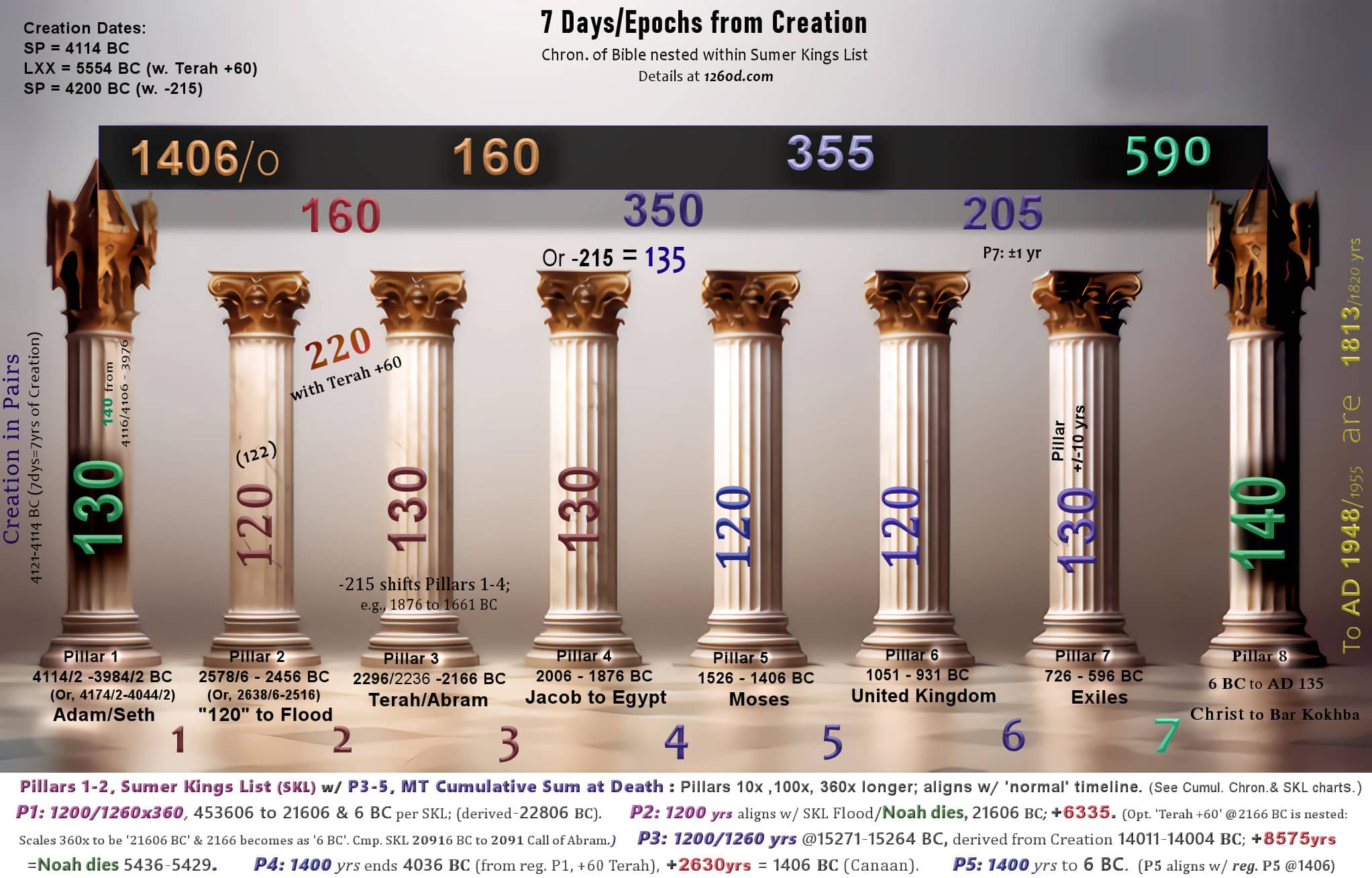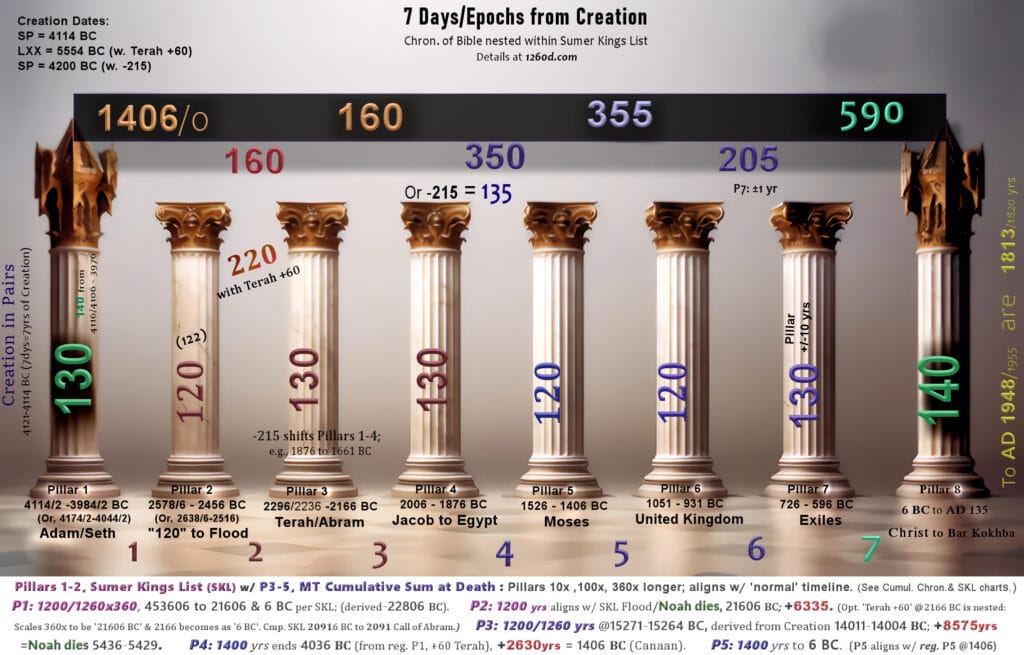Illustrating the Division of Biblical Ages Through ‘Pillars’ of 120, 130, or 140 Years as it Relates to Pairs of 23 (46).
This is still a work in progress!
This is a complex chart intended to demonstrate the fractal nature of Biblical Chronology. The author plans to explore the concept in greater detail in the future.

931/930 BC: End of the United Kingdom of Israel
726/725 BC: Fall of the Northern Kingdom (process from 733-722 BC)
596/595 BC: Fall of the Southern Kingdom (process from 605-586 BC)
Both kingdoms fell in stages, explaining the 10-year margin in the 7th Pillar.
The primary aim of this chart is to elucidate the inherent fractal patterns in Biblical Chronology. Each date adjacent to the “Pillars” acts as a natural datum. The first and last Pillars are particularly complex, featuring dual datums separated by six years. The first 130 years of Seth form the first Pillar.
The Creation account in the Masoretic Text (MT) chronology can be understood as follows:
- Creation begins with seven days (4121-4115 BC)
- Six more days pass until the Fall of Man (4114-4109 BC)
- The Fall occurs on Friday the 13th (4108 BC)
This interpretation applies the principle that “a day is as a year” to the Creation narrative. In the MT chronology, the resulting timeline spans from 4121 BC to 4108 BC, with 4114 BC as a pivotal year.
Although the nuanced relationships between Seth and Christ, identified as ‘ὁ ὡρισμένος—the One appointed’ in Acts 10:42, warrant a deeper investigation, they are not the focus here.
It’s important to underscore that the “130 years” attributed to Seth symbolize the curse incurred seven days/years after Adam’s creation, extending from Friday, the 6th, to the 13th. This notion is suggested in the Bible and explicitly stated in the Book of Jubilees (ch. 2). The Samaritan Pentateuch (SP) mostly agrees, marking a timeline that sums 7 + 700 years leading to Noah, plus an additional 600 years culminating in the Flood—1300 years in total.
Terah’s addition of 60 years (Acts 7:4) further refines this structure, forming a 6+7 (or 7+6) day/year pattern, expressed as (60+70 and 70+60). Terah symbolizes a Fallen Adam in this framework, while his son Abram represents ‘the one appointed.’ The timing of Terah’s death adds another layer of complexity, framing “Pillars 1-3” with the number 130, which symbolizes the curse. This ‘130’ symmetry starts the first era, symbolized by Creation, and closes the third era, marked by the transitional phases involving Terah and Abram as new Adam and Seth figures.
And I will put אָשִׁ֗ית enmity between you and the woman, And between your seed and her Seed; He shall bruise your head, And you shall bruise His heel.”
And Adam knew his wife again, and she bore a son and named him Seth שֵׁ֑ת, “For God has appointed שָֽׁת another seed for me instead of Abel, whom Cain killed.”
When Adam had lived 130 years, he had a son in his own likeness, in his own image; and he named him Seth.
Genesis 3:15; 4:25; 5:3 (NKJV, NIV)
Examples of the Fractal Nature of the Chronology: A House of Mirrors
In the context of Biblical chronology, the “Pillars” serve not just as chronological anchors but as interactive mirrors. They create a complex web of reflections, where various pillars bear dates that resonate with one another—forming a metaphorical house of mirrors. ‘Year 930’ serves as a case in point: it emerges as a thematic mirror that connects figures such as Adam, Moses, Solomon, and Christ through the common thread of kingship. ‘Year 930’ signifies the death of Adam (Gen. 5:5) if the chronology begins with the Creation event, denoted as “930 anno mundi.” But from the perspective of the Flood in 2456 BC, Moses’ birth in 1526 BC is also ‘Year 930’. This occurs again with Solomon and Christ.
Within our current calendrical system, which takes Christ’s birth as its anchor, 930 BC marks yet another milestone: the death of Solomon and the advent of the Kings of Israel and Judah. This confluence makes ‘Year 930’ a thematic mirror within this complex reflective system. Moses emerges as a redemptive figure, offsetting the sin originating with Adam. Similarly, Christ stands as a corrective to Solomon’s failures. Intriguingly, these four figures unite through a shared theme of kingship: Adam, sovereign of Creation; Moses and Solomon, rulers over Israel; and Christ, King of kings and Lord of lords.
The time span between Pillar 1 (Adam/Seth) and Pillar 2 (Flood) is ‘Year 1406’ (or ‘1400’). This period calculation stems from Seth’s birth that occurred “130” years after the Creation (or the day-year extension of the Fall of Man) forward until the “120 years of the Flood.” This specific numerical framework reappears in the six-year Conquest leading up to Christ’s birth, recognized as ‘Year 1406/1400’ or 1406/1400 BC when viewed from Christ’s birth year. Additionally, the 120 years leading to the Flood echo the 120 years comprising Moses’ lifespan (1526 to 1406 BC), as viewed from the perspective of the 120 years flood (P2) to the 120 years of the United Kingdom (P6), mirroring as ‘Year 1526-1406’.
From the Flood (P2) to the Conquest (P5) spans ‘Years 930-1050,’ or 931-1051 alternatively. This sequence mirrors the years stretching from the United Kingdom (P6) to Christ (P8), specifically 1050 to 930 BC. Both segments from P4 to P7 and P5 to P8 share the temporal marker ‘Year 1400.’ The interval between P5 and the final Bar Kochba exile (P8) is ‘The year 1661,’ resonating with Israel’s 215-year sojourn in Egypt, P4, dated to 1661 BC.
The span from P7 to P8 denotes ‘Year 600’ (P7 has +/-10 yrs that spans the three exiles of Judah), mirroring Noah’s ‘Year 600’ at the Flood. This numerical parallel gains significance when integrating the Long Chronology (“MT Accumulative Sum at Death”) with the Sumerian Tablets. For instance, the duration from Noah in 5436 BC to 606 BC, as outlined in the chart, amounts to 4830 (23 x 210) years (69 ‘weeks’ of 70 years each), aligning with Daniel 9:24-27. Adding complexity, the timeframe from P1 to P3 (Adam to Abraham) coincides with ‘Year 1948,’ matching 1948 AD—when Abraham’s descendants returned to the Promised Land. Consequently, May 1948 AD is ‘Year 4114’ from Abraham (P3), mirroring Creation in 4114 BC (or 3761 of SOR).
Importantly, these pivotal dates, anchored by the Pillars, construct a recurring fractal pattern within the Biblical narrative. This intricate pattern reaches its apex with the birth of Christ, who acts as the supreme mirror around which all lesser mirrors pivot. The datum point of our current era, which considers the 6 BC nuance, serves as this ultimate mirroring axis. It reflects the BC and AD epochs while also encapsulating the lesser mirrors denoted by the Pillars.
Moreover, the mirroring phenomenon is further accentuated by distinct chronological markers: (2+12) years culminates in Christ’s temple visit, as indicated in Matthew 2:16, Luke 2:42, and Isaiah 7-8. Additionally, a span of 140 years reaches the Bar Kochba revolt in AD 135 (P8), and 1400 years stretches back to the Conquest in 1406 BC (P5). Most notably, the cumulative years of all the patriarchs from Adam to Moses amass to 12600 years, which terminates at Christ’s birth, extending 14000 years from 14006 BC to 6 BC (14140 in total).
These expanding, mirror-like numerical patterns all direct attention to Christ, spotlighting His pivotal role as the apex of reflection, to which all other ancillary mirrors yield and find fulfillment. Central to this is the ’46 years’ cited in John 2:20, serving as a cornerstone from 20 BC to AD 27. This specific duration resonates broadly, being 46 x 305 years from 14004 BC, or ‘Year 4140’ (46 x 90) from Creation in 4114 BC (P1). It also measures 46 x 54 years from the Flood in 2458 BC (P2) and 46 x 32 years from the Exodus in 1446 BC.
The pattern completes its cycle with a forward extension of 46 x 30 years to AD 1406/7, mirroring P5—the year marking the deaths of Aaron and Moses and the initiation of the six-year conquest. The foundational role of the ’46 years’ in these chronologies gains added weight when considered alongside the statistical analysis for 46 and 460 (459) for birth dates of Patriarchs from Adam to Aaron, the firstborn, and his death in 1407 BC, discussed at the outset of this paper, where the Z-Scores (Sigma) were between 3.22 and 4.63 for the Long Chronology, and thus extremely unlikely to be chance, but that becomes overwhelming once the mirroring effect of the 46-year cornerstone is included in the statistical analysis.
However, the central emphasis of Chapter 7 is to examine the numerical pairings specifically associated with the number ’23’ (i.e., “46 years”). Therefore:
- With Terah +60, from Man’s formation at P1 (4176 BC or 3961 BC), ‘Year 2300’ is reached at P4.
- From Seth (P1, 3829 BC) to Aaron and Moses (P5, 1529 BC), ‘Year 2300’ is also reached.
- P2 to P8, after -215 LXX adjustment and +60 for Terah, are 2300 years.
- P3 to P8 also marks ‘Year 2300.’

931/930 BC: End of the United Kingdom of Israel
726/725 BC: Fall of the Northern Kingdom (process from 733-722 BC)
596/595 BC: Fall of the Southern Kingdom (process from 605-586 BC)
Both kingdoms fell in stages, explaining the 10-year margin in the 7th Pillar.
Exploring Pairs of 23 (46) in the Seven Epochs Chart
When the Pillars themselves are excluded—akin to measuring gaps between doorways while disregarding the frames—the sum of intervals between Pillars 1 and 5 equals 2070 years (‘1400 + 160 + 160 + 350 = 2070’). This can be further divided into 23 x 90 or 46 x 45. This sets the stage for 3220 years from Pillar 1 to 8 (2070 + 1150), equating to 23 x 140 or 46 x 70.
Transitioning to Pillars 5 through 8, the total years for these final three spans sum to 1150 years (23 x 50; 46 x 25). When these transitional Pillars are excluded, the chronological stretch from ‘1406 BC’ to ‘6 BC’ also equals 1150 years, computed as ‘355 + 205 +590’ (Daniel 8).
The chart underlines the theme of numerical pairing in the Bible. When counted inclusively and exclusively, the spans between even and odd pillars amount to 1260 x 1260 (7 x 360). This extends the seven days of Creation into a symbolic seven years. Notably, Pillar 7 has +/ 10 years.
These Biblical eras intriguingly intersect with the Long Chronology and the Sumerian Kings List.
Other posts about Enoch and his calendar
- Enoch: Tribulation Witness
- Is the Book of Enoch Inspired?
- Enoch’s Prophecy of 7 cycles of 490
- Part One: How the 364-day calendar works
- The Key of 23 — Serpent into a rod
- Enoch calendar is also Pi to 22nd decimal
See “The Pillars of Time.”